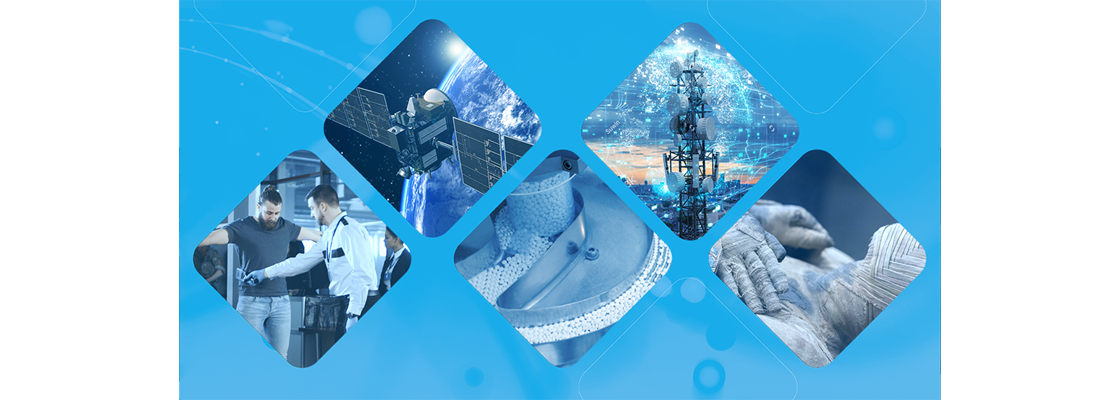Terahertz waves can penetrate a wide variety of non-conductive materials, such as fabrics, paper, cardboard, wood, plastic, foam, ceramic and even walls. They are capable of identifying materials hidden behind obstacles and of examining them layer by layer. In this way they allow the imaging, identification and analysis of a broad spectrum of terahertz traces.
Due to their unique properties, THz waves are of considerable interest for a multitude of applications. They are non-ionizing, that is to say that they do not damage the objects that they pass through, and therefore are not harmful to health. By reading this article you will discover concrete examples of THz applications.
Security checks
In order to detect terrorist threats in high-traffic areas, bags and baggage are generally inspected with X-rays while people pass through a metal detector. However, metal detectors are incapable of detecting explosive devices with a low density of metal or non-metal handguns. These objects may be found by a frisk search, but because of the high volume of persons entering, people are searched only if an alarm is triggered or there is some suspicion.
Terahertz technology is the basis for the development of several tools that make it possible to detect, without contact, threats on individuals, such as:
- Body scanners integrated in gates which are used to supplement metal detectors as a contactless frisking tool,
- In the near future, travellers who pass through a security check could be subjected to a contactless frisk search carried out using a THz high resolution portable active imaging device,
- In high-traffic areas such as airports, a surveillance camera operating in the THz field would allow threats to be identified much sooner, before they even arrive at the security check.
The terahertz technology used in the context of security checks enables the efficacy of these checks to be improved via the detection of a larger number of threats and allows the reduced occurrence of pat-down searches which prove intrusive for those who undergo them and which are often embarrassing for those who carry them out. To find out more about the security applications of terahertz, watch the webinar Eliminate discomfort without compromising security during manual pat-down screening.
Inspection of mail
Today, the vast majority of threats that arrive by mail are powders, liquids or electronic devices which are found in envelopes or small parcels. Since most packaging materials used are transparent to THz waves, mail inspection systems operating in this area have recently appeared on the market. They allow the content of an envelope or box to be observed in total security through several visually opaque layers of paper, cardboard, plastic, foam, fabric, etc.
To find out more discover the solution Mailsecur developed using an INO technology.
Astronomy
Astronomers were among the first to take an interest in the potential of THz waves. For several years now, terrestrial and space telescopes have detected cosmic THz radiation to study the early universe. The spectroscopic signatures obtained reveal the presence of chemical elements and of molecules that cannot be detected in other spectral bands including the far-infrared.
Life sciences
Terahertz technology has also numerous applications in the field of life sciences. Here are several examples of these:
- Despite their low level of penetration into biological tissues composed mostly of water, terahertz waves are used in several medical imaging or THz spectroscopy applications which use this property to their advantage. They equally allow the detection of invisible cancers, the detection of early caries under tooth enamel, the study of the hydration of tissues or cells, the analysis of structural damage to molecules such as carbohydrates, proteins, cholesterol crystals or DNA.
- In the pharmaceutical field, THz-TDS spectroscopy allows the study of the structural polymorphism of drugs. Different spectral forms of active pharmaceutical ingredients (API) have already been identified by THz analysis. THz is also used to characterize sustained release tablets (SRT) which are composed of different active pharmaceutical substances (multilayer tablets). The interior of the tablet is probed by ultra-short laser pulses which are reflected by each layer to a greater or lesser degree according to their refractive index. This allows the formation of a contrasted image in a non-destructive manner. This terahertz pulsed imaging technique (TPI) has the advantage of providing quantitative information on the properties of these layers: the thickness of the encapsulation, the reproducibility, distribution and uniformity of the coating.
The environment
The discriminating power of THz waves should allow the remote detection of polluting or toxic gases in the atmosphere by absorption spectroscopy. Several gases such as hydrogen disulfide or ozone produce a typical absorption spectrum in the THz field while they are difficult to detect in the visible or infrared spectra. This is also the case for lethal chemical or biological agents including mustard gas, sarin and anthrax which display a unique THz signature.
To detect these substances at a distance of several dozen meters, the scene must be illuminated with a THz beam that is sufficiently powerful for the energy reflected by the gas molecules to return to the detector. This is a major challenge since the spectral range of interest coincides with that where the air is very absorbent, causing considerable signal attenuation. Efforts to develop both powerful compact THz lasers and ultra-sensitive spectroscopy detectors are continuing.
Telecommunications
THz should play a decisive role in the development of wireless networks of the future that will have to satisfy a rapidly increasing demand for bandwidth. As THz frequencies are higher than those of the radio waves and Wi-Fi that are currently used, they should allow significantly higher data transmission speeds to be achieved (> 10 Gbps).
THz waves will also facilitate lossless satellite communications over long distances.
Culture and history
What link can be established between terahertz waves, culture and history?
Terahertz technology has been used particularly in the analysis of Egyptian mummies to look layer by layer at that which cannot be seen with the naked eye or with X-rays. It is for the same reasons that terahertz waves are used to examine works of art. THz waves allow each layer of paint under the surface to be seen while X-rays travel directly to the canvas. Let us not forget that the greatest artists recycled their canvases by painting new works on already painted canvases. This is how the signatures of famous artists were found hidden under several layers of paint.
Non-destructive quality control
Since the use of terahertz waves does not damage the objects that they pass through, one of the flagship applications of terahertz technology is to conduct an inspection of samples without destroying them. This offers the possibility of inspecting 100% of components or of assembled products, packaged or not, to detect production faults and to provide quality control.
In many industries such as the manufacturing, pharmaceutical or food processing industries, terahertz technology allows the detection of production errors before these impact the production chain in order to reduce the costs associated with non-quality and to deliver the best products to customers. Destructive tests could be avoided in many situations by leveraging the penetrating power of THz waves.
To learn more about the use of terahertz technology to control the quality of assemblies and packaged products, read the blog article Terahertz imaging: for safe, in-depth inspection in real time.
The inspection solutions that make use of THz waves have the advantage of being safe for the workers who use them since the energy emitted in the THz spectrum is not ionizing. These solutions are therefore simpler and less costly to implement than a system that uses X-rays. Compact systems are already on the market, including portable devices better suited to some applications.
Terahertz technology can see through certain materials such as plastic. Learn more about its use for the non-destructive inspection of plastic parts, by watching the webinar How to immediately detect hidden defects during the production of plastic parts.
The applications of terahertz technology are varied and concern many industries. The safety of terahertz waves and their property of layer by layer penetration make them a non-destructive inspection tool and a contactless detection tool with proven value in many fields of application.



